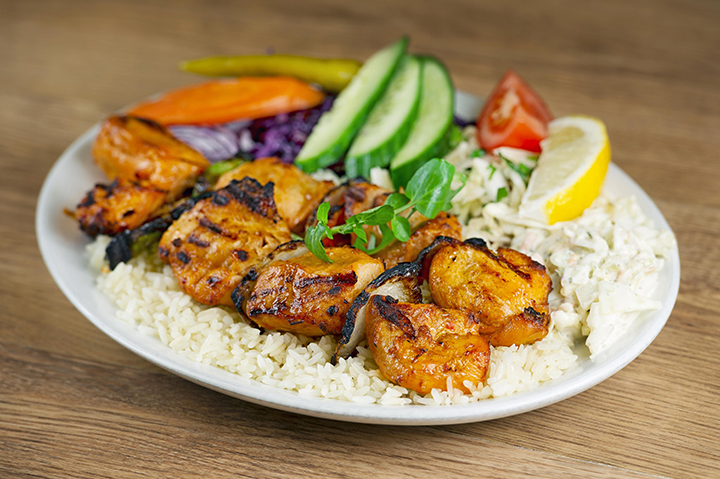 |
|
| Issue #102 • November/December, 2006 |
Despite being omnivores endowed with the ability to eat nearly everything, we humans are very selective about what we consider acceptable food. A close look at the culinary habits of people in any region of this planet will reveal that a mere handful of the edible plants and animals form the core of the cuisine. This is in part due to the advent of agriculture and its influence on human development. Currently, humans cultivate only about 600 plant species and 50 animals out of edible varieties that number in the thousands. The actual selection varies depending on where you live.
We even resist any changes or deviations in our selection. It’s an innate response for us to distrust foods we perceive as strange, often fearing that they offer us some harm or discomfort. We do this even when our health and longevity will benefit from a change in the type and amount of food that we consume.
|
Think back, if you dare, to your last experience with the flu, serious cold, or any other condition that produces fever and/or stomach upset. Often, during periods such as this, the last thing you can envision is eating food of any kind, even though a cup of broth, a dish of jello, or a cup of tea would, if nothing else, help you to feel better by replacing nutrients your body needs to rebuild itself. And even though a well-prepared cup of hot, homemade beef, chicken, or vegetable broth would be both nutritious and good tasting, you’ll reject it.
While managing kitchens that prepared and served food to patients in hospitals, nursing homes, and retirement communities, I was often witness to the powerful healing potential of well-prepared food served in appropriate portions to folks with a wide variety of medical problems. For patients and residents in these facilities, food can, and often is, a vital element for accelerating healing and lifting the spirits. Monitoring the quality of the food served to patients and residents is considered a critical and mandatory function. In this setting, food that is prepared incorrectly or presented in an unattractive manner is almost always rejected. When the body is already weakened by illness or age, a negative experience at any given meal will often make matters worse.
Let’s bring this scenario closer to home. Consider being advised by your doctor that your bad cholesterol, the Low-Density Lipoprotein (LDL), has gone through the roof, and your weight is way out of the normal range for your age and height. You are also told (as if you didn’t already know) that food is the culprit. You must make drastic changes in your eating habits to prevent serious health problems.
|
Does this mean that you are doomed to a dietary hell of raw carrot and celery stick salads and steamed asparagus on dry whole wheat toast? No, but we all need to develop an eating pattern that provides, in sufficient quantity, the healthful food we need and reduces the consumption of foods that can cause health problems. And, it is not necessary to be a culinary master, nutritionist, or registered dietitian to accomplish this goal.
Surprisingly, the list of foods to avoid is much smaller than the list to embrace. Fats, sugar, salt, and carbohydrates do not really deserve the killer image in which they are cast. Eating any food in excess can cause health problems.
For instance, all fats deliver the same number of calories. If your goal is to lose weight, substituting olive oil for butter is not enough. Reducing your intake of all fats must be considered.
Also, the proper use of salt in cooking will eliminate the need for the salt shaker at the table.
And you should also realize that adding two teaspoons of sugar to your morning coffee is not necessarily a problem when you consider that more than half of the sugar ingested in this country comes hidden in many processed items sitting on supermarket shelves. What is important is limiting our intake of all sugars which, according to The World Health Organization, should be 10 percent or less of our total daily calories (about 10 teaspoons). The way I see it, the two teaspoons of sugar that go into your morning coffee are not a problem. The unseen sugar in a can of soda or a bottle of ketchup could be, simply because it’s more difficult to calculate the intake of sugar from these sources.
The road to developing and implementing an overall healthier lifestyle, in which diet plays a substantial role was, in very simple terms, mapped 47 years ago by the noted cardiologist Ancel Keys. His advice:
“Don’t get fat; if you are fat, reduce. Favor fresh vegetables and fruits. Avoid the heavy use of salt and refined sugar. Get plenty of exercise and outdoor recreation. See your doctor regularly and do not worry.”
|
I will add to his recommendations: Eat less junk food.
The impact of eating an occasional hamburger, a few french fries, and a can of soda as part of an otherwise healthful diet is going to be small or nonexistent. But we should not make it a habit. What matters most is our habitual eating pattern. As a general rule, eat less (especially of foods containing saturated fat), exercise more, and eat lots of fruits and vegetables.
My kitchen
I believe one of the essential keys to adopting a healthful eating regimen is setting up a healthy kitchen and stocking it with food items that suit the individual and diverse culinary preferences of your family. You cannot impose a diet that people are going to reject as foreign to their tastes, because it will fail.
In the last article I mentioned two kitchen utensils that have become standards in my kitchen: A selection of affordable nonstick cookware and the Cuisinart Mini-Prep food processor.
Good measuring spoons
Last month while making a cake for a group of my wife Tricia’s special students as a reward for class achievement, I discovered that two pieces from my favorite set of measuring spoons were missing. So I rushed to Wal-Mart to buy a new set.
I am not one that believes in or practices the imprecision of eyeballing ingredients, especially when baking. My Wal-Mart set was cheap and got me through my perceived emergency, but I was not satisfied with how they performed. The plastic handles were hard to hold and the spoons were of the shallow design that allow easy spillage when measuring liquids. So I logged onto Amazon.com, my favorite kitchen equipment supplier, to look for something better. What I found was a set of heavy-gauge, stainless steel measuring implements. The set included four measuring cups in 1/4, 1/3, ½ and 1-cup sizes, and a set of deep-bowl measuring spoons in 1/8, 1/4, ½ and 1-teaspoon sizes along with a 1-tablespoon measure. The measuring spoons have a unique and clever design—a bend at the end of the handle that allows the spoon to sit upright on its own. The set also comes with a lifetime warranty. This set is for anyone who does as much cooking as I do and is inconvenienced by the performance of faulty equipment.
The set is made by Cuisipro and costs about $30. If you don’t need the measuring cups, you can buy the spoons for about $11.
When I outline the flavor-enhancing value of herbs and spices in the next article, a real emphasis on accurate measurement will be essential to achieving success, and a quality set of measuring tools will prove to be indispensable.
Crucial kitchen knives
Like most folks, I believe the greatest cook who ever lived was my mother. She was very meticulous when it came to buying and caring for her kitchen utensils, especially her knives. At a young age, she taught me the value of owning a high-quality set of kitchen knives as well as how to care for them.
She owned four high-carbon steel knives that she bought on sale in 1960 at one of Boston’s best known knife retailers. These knives are still used in my kitchen today. Her complete knife set included a 10-inch cook’s knife, a small paring knife with a 4-inch blade, a straight back boning knife with a 6-inch blade, and a nonserrated slicing knife with a 12-inch blade. Her favorite was the cook’s knife. While using this knife, she would often stop working and remind me that, “This is the most important tool in this kitchen.”
|
To keep her knives razor sharp, she used a whetstone and a butcher’s steel. To prevent her knives from staining, she carefully washed and dried them after each use. The knife set pictured contains knives made of high-carbon stainless steel, a hard metal that, once sharpened, will stay sharp during repeated uses. Unlike my mother’s knives, they do not stain. This set is the workhorse of my kitchen and if I travel to visit friends or family, my knives go with me. I never know when they will ask me to prepare a meal.
The straight back boning knife is invaluable for sliding between bones and under silver skin (that shiny stuff you see that’s connective tissue) on beef, pork, and lamb. The 10-inch cook’s knife has a long, gently sloping curvature, which is necessary to achieve the necessary rocking motion when mincing and chopping.
Restoring a knife’s edge
The butcher’s steel is not a sharpening tool. It’s main function is to straighten the knife edge when it becomes feathered. “Your blade is feathered,” is industry-speak for describing a knife edge that has become slightly bent from repeated use. If the knife you are using is a quality blade made from high carbon stainless steel, and seems to be losing its edge, the usual cause is feathering.
The butcher’s steel will restore the edge. Safe and effective use of it is simple:
1. Place a kitchen towel on a cutting board to prevent the steel from slipping. Position the steel perpendicular on the towel (i.e., with the handle “up” so you can grasp it with your noncutting hand). Firmly grasp the knife in your cutting hand, and place the heel of the knife (the area near the knife’s handle) against the steel. Hold the blade at a 20° angle against the steel.
2. While maintaining the 20° angle, use a light pressure, and slide the blade down the steel while pulling the knife toward you at a rate so that the tip of the blade has passed over the steel completely when you get to the bottom.
3. Repeat the same motion on the other side of the blade. Four or five strokes on each side should return the edge to its original sharpness. If it doesn’t, the knife has lost its edge and must be sharpened. If you are not practiced in knife sharpening techniques, I recommend having a professional do it. Many supermarkets will sharpen knives for free. They use an industrial-grade electric sharpener that removes some metal from the blade with each sharpening. If this really concerns you, I suggest you buy a good diamond-dust sharpening stone and practice sharpening your own knives. I will include some knife sharpening tips in the next “the healthy kitchen” article.
Well, it’s time to do some cooking. The following recipes were developed with a substantial contribution from a small garden that I plant in front of my house every spring. During the spring, summer, and fall months, I save a lot of money by planting a variety of herbs, salad greens, and vegetables. This year my garden contained basil, thyme, oregano, rosemary, dill, mint, and cilantro.
These herbs share space with two varieties of tomato, a bed of carrots, two varieties of chili peppers, and a small bed of mesclun salad mix. This fall I will plant a hardy fall and winter salad mix.
Once you have discovered the incredible flavor boost that garden-fresh herbs give all foods, you will look forward to cooking with them as often as possible. I will discuss herbs and spices in considerable detail in a future article.
Chili
Chili is one of those one-dish comfort foods that I can’t imagine living without. I fell in love with chili after reading Frank Tolbert’s book, A Bowl of Red, in 1968, two years after it was published. Unfortunately, some of the best chilies are made using lots of saturated fat and red meat. Not exactly heart healthy food. So, for the past several years I have been experimenting with different chili formulas, some of which are meatless and others that contain meat.
In the Mediterranean, meat is often incorporated into recipes as a flavor and texture enhancer. In her book Mediterranean Cooking, Paula Wolfert includes several couscous recipes in which meat plays such a role. These recipes are loaded with vegetables and grain. Meats like beef, pork, lamb, and chicken are used as condiments to add balance, taste, and texture.
With this in mind, I set out to develop a chili recipe using this format. The following low-fat recipe uses some ingredients that are not chili fare, but my recipe review committee, after eating chili three times, gave it a unanimous thumbs up. Try it. I assure you that it is long on real chili flavor and delivers a lingering chili pepper warmth that satisfies.
I use both fresh and dried poblano chilies, a combination that contributes a fresh, lively taste that can only be attained with fresh peppers, along with deep, rich flavor found in dried peppers. I added anchovies and Parmesan cheese rinds to replace the rich taste that is associated with animal fat. I buy Parmesan cheese rinds at the deli counter in a local supermarket. These rinds are simply cheese that has hardened during the aging process. They are packed with flavor and can be used as a flavor booster in any soup or stew. They are also cheap, about $2 a pound. The rest of the Parmesan wheel sells for about $13 a pound, and the flavor is the same.
The baking chocolate I use is optional, but it adds “depth” to the flavor of the recipe. It’s worth a try.
Ingredients:
2 fresh poblano peppers, peeled, seeded, and deveined
2 dried poblano (a.k.a. ancho) peppers, seeds and veins removed
4 ears fresh corn (remove the kernels, discard the cobs) or 12 ounces of frozen corn
3 anchovy fillets, chopped fine
1 canned chipotle pepper in adobo, chopped fine
2 Tbsp. cumin seeds, toasted and ground
1 Tbsp. coriander seeds, toasted and ground
1 bay leaf
1 tsp. dried oregano
1 Tbsp. chili powder
1 Tbsp. peanut oil
1 lb. boneless top round steak with all visible fat removed, cut into 1/2-inch pieces
2 cups yellow onion, chopped
6 cloves fresh garlic, minced
1 28-ounce can diced tomatoes, with juice
3 Tbsp. tomato paste
12 ounces of fresh apple cider (preferred) or unsweetened apple juice
1 14-ounce can reduced sodium vegetable stock
2 pieces Parmesan cheese rinds, approximately two ounces
½ ounce bitter-sweet baking chocolate (optional)
1 15-ounce can pinto beans, drained and rinsed
1 15-ounce can black beans, drained and rinsed
salt and freshly ground black pepper to taste
Method:
1. Set your oven to broil and adjust one of the shelves to the middle position. Remove the stems from the fresh poblano chilies by cutting around the base of the stem with a paring knife. Cut the chilies in half, from stem to tip, and remove the pulp and seeds. Arrange the seeded peppers on a foil-lined cookie sheet, skin side up, and place them under the broiler until they are evenly browned and blistered. Remove them from the oven and place them in a plastic bag. Seal the bag and let the peppers steam for about 15 or 20 minutes. While the fresh peppers are steaming, set the oven to bake at a temperature of 400° F. Set the dried peppers on a foil-lined cookie sheet and roast them in the oven until they are lightly browned. Take them out and set them aside to cool for a few minutes. You can now peel the skin from the roasted fresh peppers with little effort. Dice these peeled peppers and set them aside in a small bowl. Remove the stems and seeds from the dried peppers, break them into small pieces, and set them aside in the bowl with the fresh roasted peppers.
|
2. If you are using fresh corn, remove the kernels from the cob using a paring knife. Set the corn kernels aside. Chop the anchovies and the chipotle peppers and set them aside in the same bowl containing the fresh peppers.
3. Toast the cumin and coriander seeds in a small nonstick skillet over medium heat until they become fragrant. Set them aside to cool. Once cooled, grind them to powder and combine them with the bay leaf, oregano, and chili powder. Set this mixture aside.
4. Heat one tablespoon of oil in a large nonstick Dutch oven or other suitable size heavy-bottom pot until it starts to ripple. Add the diced beef and sauté until the beef starts to brown. Add the onions and continue cooking until the onions soften and turn translucent. Add the garlic and cook for about 30 seconds or until the garlic becomes fragrant.
5. Add the diced tomatoes with their juice, tomato paste, cider, and vegetable stock to the Dutch oven. Bring this mixture to a simmer over medium heat, stirring frequently to prevent sticking and scorching. Reduce the heat to a point where the chili is at a slow simmer. Add the seasonings, peppers, corn, anchovies, spice mixture, and Parmesan cheese rinds. Continue simmering over low heat for about an hour or until the beef is tender.
6. When the chili is ready, gently fold in the drained and rinsed beans. Adjust the seasoning by adding salt and freshly ground black pepper to taste.
Makes 8 to 10 servings with about 380 calories and 8 grams of fat per serving.
Note: Easy with the salt. Remember, the main function of salt is to enhance flavor. If you can taste the salt in your cooking, you’ve added too much.
Garden mushroom and vegetable lasagna
This recipe is a salute to the treasures of my home garden and the flavorful fresh vegetables and herbs that it delivers every growing season.
Be sure to use Italian fontina in this recipe; it has a rich buttery taste and melts beautifully, helping the various layers of this lasagna hold together. The portobello mushrooms are a favorite when I need a flavor substitute for meat. If cholesterol is not a problem, you can substitute one large egg for the egg substitute. The egg serves only as a binding agent for the ricotta cheese mixture. The Barilla no-boil lasagna noodles are great for this recipe because they are not as thick and dense as the traditional noodles. They cook to a perfect tenderness in this recipe.
Ingredients:
approximately 6 portobello mushrooms (with 4 to 6-inch heads), rinsed well and drained
1 Tbsp. olive oil
2 cups fresh zucchini, seeds and pulp removed, cut into 1/4-inch slices on the bias
15 ounces low-fat ricotta cheese
¼ cup egg substitute (or one large egg)
2 Tbsp. low-sodium chicken stock
2 Tbsp. fat-free yogurt
2 large shallots, minced
4 garlic cloves, minced
¼ cup fresh parsley, minced
1 Tbsp. fresh thyme, minced
½ tsp. dried oregano
9 sheets no-boil Barilla lasagna
1 ½ cups homemade or canned marinara sauce
¼ cup coarsely chopped fresh basil leaves
½ cup shredded Parmesan cheese
1 ½ cups shredded Italian fontina cheese (about 5 ounces)
¼ cup shredded Parmesan cheese (this is separate from the Parmesan cheese above)
1/3 cup sun-dried tomatoes
3 vine ripened tomatoes, sliced about 1/3 inch thick
1 tsp. dried Italian seasoning
1/3 cup pale dry sherry
Method:
1. Adjust an oven rack to the middle position and preheat the oven to 400° F. Cut each of the portobello mushrooms in half, position the cut side of each mushroom half down on the cutting board and cut them into 1/2-inch slices. Place the cut mushrooms into a suitable size bowl. Add one tablespoon of extra virgin olive and gently toss to coat the mushrooms. Place the coated mushrooms in a single layer on a cookie sheet and roast in the oven until they start to shrivel and most of their liquid is gone, about 15 minutes. Set them aside to cool. Remove the stem from each zucchini and cut each of the squash in half on the vertical. Using a teaspoon, gently remove the seed pulp from the middle of each half. Slice each half into ¼ inch thick slices. Lightly coat a cookie sheet with a nonstick spray, distribute the zucchini slices in a single layer, and roast the squash for about 10 minutes or until it begins to soften. Sautéing the squash in a 10-inch nonstick pan, coated with a nonstick spray, also works well.
2. In a suitable size bowl, combine the next nine ingredients and gently blend them together with a wooden spoon or rubber spatula.
3. Coat a 9×13-inch baking dish with nonstick spray. Arrange three no-boil lasagna noodles in the baking dish, according to the directions on the box. Spread half of the seasoned ricotta cheese mixture over the noodles. Evenly spread the mushrooms and zucchini over the cheese mixture. Top with three more sheets of lasagna noodles. Spread the marinara sauce over the noodles. Distribute the fresh basil over the sauce. Sprinkle ½ cup of shredded Parmesan cheese and one cup of the fontina cheese over the sauce. Top with the last three sheets of lasagna noodles. Spread the remaining spiced ricotta cheese mixture over the noodles and top with the sun-dried tomatoes. Lay the fresh tomato slices over this and evenly spread the remaining ½ cup of Fontina and ¼ cup of shredded Parmesan cheese. Finally, sprinkle the dried Italian seasoning on top.
4. Evenly pour the dry sherry over the lasagna. Tightly cover the dish with a piece of aluminum foil and bake in the oven at 400° F for one hour. After removing the lasagna from the oven, let it rest for at least 20 minutes before serving.
Makes 12 servings with approximately 260 calories and 10 grams of fat per serving.
Latin-style chicken & rice
(Arroz con pollo)
This is the full-flavored cousin of American-style chicken and rice. In Latin countries, this is a basic comfort food. I use a medium-grain brown rice that I have only been able to find in an Asian supermarket in nearby Hartford, Connecticut. Unlike many other brown rice varieties, it does not rupture or curl when cooked in a casserole like this one. The poblano peppers that I use are grown in Oxnard, California. The flavor and texture of these peppers is the same as those grown in many parts of Mexico. If you can’t find fresh poblanos, you can substitute a green bell pepper. It’s not a great substitution, but it works.
Marinade ingredients:
1 tsp. ground coriander powder
½ tsp. ground cumin seed
1 tsp. chili powder
½ tsp. ground cinnamon
1 small garlic clove, minced very fine
1 tsp. dried oregano
1 Tbsp. olive oil
1 tsp. lime juice
|
Main ingredients:
8 bone-in, skinless chicken thighs, excess fat removed
1 fresh poblano pepper
1 tsp. olive oil
2 cups Asian medium brown rice or basmati brown rice
1 medium onion, diced medium
1 fresh garlic clove, minced
1 tsp. ground turmeric
1 chipotle pepper in adobo, minced
2½ cups reduced-sodium chicken stock
1 8-oz. can tomato sauce
1/3 cup green olives pitted and halved
1 Tbsp. capers
½ cup jarred roasted red peppers, diced medium
1 tsp. extra virgin olive oil
1 tsp. white balsamic vinegar
2 Tbsp. fresh cilantro, chopped
salt and fresh ground black pepper to taste
Method:
1. Combine the marinade ingredients in a small bowl. Combine the marinade and the skinned and defatted chicken thighs in a large zip lock freezer bag, and place them in the refrigerator for one hour. Preheat the oven to 450° F. Remove the thighs from the marinade and place them on a cookie sheet coated with nonstick spray. Place the tray in the oven, and bake the chicken for 20 minutes or until the chicken starts to brown on the surface. It is not necessary to cook the chicken completely at this point. When cooked to the desired degree, remove the chicken from the oven and set it aside.
2. Remove the stem and seeds from the pepper; cut the pepper the long way and roast the pepper in a dry heavy-bottom pan over medium-high heat until the skin is blistered. Place the pepper in a plastic bag for about 15 minutes to steam. Remove the pepper from the bag, peel off the skin, then dice and set the diced pepper aside.
3. Heat one teaspoon of oil in a 10-inch, nonstick sauté pan, add the raw rice and cook, stirring frequently until the rice is a light brown. Add the onion and garlic and continue cooking for another minute until the onion and garlic become fragrant. Remove the pan from the heat and stir in the ground turmeric and chipotle pepper. Set the mixture aside.
4. Combine the chicken stock, tomato sauce, green olives, and capers in a 10-inch Dutch oven over medium high heat and bring the mixture to a slow simmer. Add the rice mixture and partially cooked chicken. Cover, reduce the heat and cook the rice for about 25 minutes or until the chicken is cooked completely. Remove the chicken from the pot and set it aside to cool enough so that meat can be separated from the bone. Continue cooking the rice over low heat until all of the liquid is absorbed.
5. While the rice is cooking, remove the bones from the chicken. Break each thigh into four or five medium pieces. In a suitable size bowl, gently toss the pulled chicken meat with roasted peppers, olive oil, vinegar, and cilantro. When the rice is completely cooked, gently fold the chicken mixture into the rice and cover the pot for about 5 minutes to reheat the chicken. Adjust the seasoning with a little salt and pepper. Serve immediately.
Makes about 5 to 6 servings of approximately 285 calories and 9 grams of fat per serving.
BBQ vegetable and lamb kabobs
For folks who live by the grill, as the Blunt family does, meat is an essential offering. When meat is on our outdoor BBQ menu, lamb is a favorite. I always buy American lamb because it is less gamey than its Australian or New Zealand counterparts. I usually buy a whole bone-in leg with the butt end removed and bone it myself. This gives me enough meat to use with a long list of recipes, from Mediterranean couscous to Middle Eastern Bulgar salads and, of course, barbecue.
The sometimes gamey flavor in lamb comes from the fat. Removing as much fat as possible not only makes this delightful meat healthier, it also tastes better. Check the photos if you are wondering about the size of the cut vegetables. You can also ask the butcher at most supermarkets to cut the lamb chunks from the large leg muscle and wrap the rest for you to take home and freeze. Don’t worry, there is definite role for lamb in a heart healthy kitchen. More recipes will follow.
Main ingredients:
2 lbs. lamb leg, cut into 1 ½ to 2-inch chunks
1 fresh pineapple, trimmed, cored, and cut into two-inch chunks
1 medium green pepper, cut into one-inch pieces
1 medium red pepper, cut into one-inch pieces
1 large red onion, cut into pieces
|
Marinade ingredients:
3 cloves finely minced garlic
1 tsp. ground cumin
½ tsp. dried marjoram
1 Tbsp. toasted sesame seeds
1 Tbsp. pure vanilla extract
4 Tbsp. cranberry juice
2 Tbsp. walnut or extra virgin olive oil
½ tsp. Kosher salt
1 tsp. fresh ground black pepper
Method:
1. Combine the marinade ingredients in a suitable size stainless steel or glass bowl. Add the diced lamb and toss to coat evenly. Cover and refrigerate until fully seasoned, at least 4 hours or up to 24 hours.
2. When you are ready to start cooking, fire up the grill. I fill my large Weber chimney with charcoal, about four pounds.
3. Using 12-inch metal skewers, I construct each kabob as follows: Thread each skewer with a piece of pineapple, a stack of onion, a chunk of lamb, and one piece of each kind of pepper. Repeat the sequence three times. (The photo shows that.)
4. Grill the kabobs uncovered until the meat is browned and cooked to medium or medium rare, depending on your preference. Turn the kabobs every minute or so to cook all sides evenly. Serve immediately.
6 servings of 300 calories and 11 grams fat per serving.
Brown rice salad
Here is a salad that is a perfect complement to grilled lamb and vegetables. It is enhanced with a lively balsamic vinegar dressing that adds balance to the full flavor of lamb.
This recipe really demonstrates that low-fat, high-fiber food need not be dull and flavorless. You will notice I use regular olive oil to cook the rice and extra virgin olive oil in the dressing. Extra virgin olive oil is expensive and has a fruit flavor that, I feel, is diminished with the level of heat that is required to sauté the rice. I will, however, use it to sauté vegetables at a lower heat range.
Ingredients:
1 ½ cups Basmati brown rice
1 tsp. olive oil
1 garlic clove, minced
1 large shallot, minced
3 cups reduced-sodium canned or homemade vegetable stock
Dressing ingredients:
2 Tbsp. extra virgin olive oil
2 Tbsp. white balsamic vinegar
½ cup Italian broad leaf parsley, minced
¼ cup fresh cilantro, minced
2 Tbsp. fresh mint, minced
Topping ingredients:
2/3 cup dried cranberries
½ cup toasted pistachio nuts
Method:
1. Soak the rice in four cups of warm water for about 20 minutes. Drain the rice and rinse in cold water. Drain the rice again in a wire mesh strainer.
|
2. While the rice is draining, heat the olive oil in a nonstick 10-inch skillet over medium-high heat until it ripples. Do not allow it to reach the smoking point. If it does, discard it, wash the pan, and start over. The smoke from overheated vegetable oil is toxic and a known carcinogen.
3. Shake the rice to remove any remaining water and add the rice to the hot pan. Cook the rice, stirring frequently until it begins to brown. Add the minced garlic and shallot and cook for about another minute or until the garlic becomes fragrant.
4. Combine the rice and vegetable stock in a two-quart sauce pan and bring it to a gentle boil. Reduce the heat, cover the pot, and continue cooking the rice at slow simmer until all the stock is absorbed, about 40 to 45 minutes. Uncover the rice, transfer it to a suitable size bowl and set it aside to cool for about 20 minutes.
5. While the rice is cooling, prepare the dressing by combining those ingredients and tossing gently. Add the dressing to the rice and mix gently with a wooden spoon or rubber spatula.
6. You can serve this salad warm or cold. Just before serving, sprinkle the nuts and cranberries on top.
8 servings of 225 calories and 7 grams of fat per serving.
Well, it seems that developing a heart healthy kitchen isn’t at all dull and lacking of culinary excitement. Please read Dr. Willett’s book. When it comes to down-to-earth nutritional advice supported by solid research, I am convinced that you can’t do better. Let me know what you think.
6. You can serve this salad warm or cold. Just before serving, sprinkle the nuts and cranberries on top.
8 servings of 225 calories and 7 grams of fat per serving.
Well, it seems that developing a heart healthy kitchen isn’t at all dull and lacking of culinary excitement. Please read Dr. Walter C. Willett’s excellent book, Eat, Drink and be Healthy. When it comes to down-to-earth nutritional advice supported by solid research, I am convinced that you can’t do better. Let me know what you think.






















